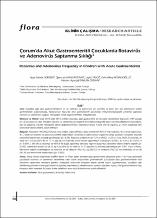Çorum'da akut gastroenteritli çocuklarda rotavirüs ve adenovirüs saptanma sıklığı

Göster/
Erişim
info:eu-repo/semantics/openAccessTarih
2017Yazar
Güreser, Ayşe SemraKarasartova, Djursun
Taşçı, Leyla
Boyacıoğlu, Zehra İlkay
Taylan Özkan, Hikmet Ayşegül
Üst veri
Tüm öğe kaydını gösterKünye
Güreser, A. S., Karasartova, D., Taşçı, L., Boyacıoğlu, Z. İ., Taylan Özkan, H. İ. (2017). Çorum'da akut gastroenteritli çocuklarda rotavirüs ve adenovirüs saptanma sıklığı. Flora İnfeksiyon Hastalıkları ve Klinik Mikrobiyoloji Dergisi, 22(2), 58-66.Özet
Giriş: Çocukluk çağı akut gastroenteritlerine en sık rotavirüs ve adenovirüs yol açmakta ve kesin tanı için laboratuvar testleri gerekmektedir. Çalışmamızda, hastanemize başvuran akut gastroenteritli çocuklarda immünokromatografik yöntemle saptanan rotavirüs ve adenovirüs sıklığının retrospektif olarak değerlendirilmesi amaçlanmıştır.Materyal ve Metod: Ocak 2013-Eylül 2014 tarihleri arasında, akut gastroenterit ön tanısıyla hastanemize başvuran 3189 çocuğa (0-18 yaş arası) ait dışkı örnekleri rotavirüs ve adenovirüs için kalitatif immünokromatografik kaset test (AbonBiopharm Rota/Adeno, Çin) ile çalışılmış, kayıtlar retrospektif olarak değerlendirilmiştir. İstatistiksel analiz ki-kare testi ile yapılmış, p< 0.05 olduğunda fark istatistiksel olarak anlamlı kabul edilmiştir.Bulgular: Hastaların 706 (%22.1)'sında viral antijen tespit edilmiştir. Dışkı örneklerinin %17.5'inde rotavirüs, %3.3'ünde adenovirüs, %1.3'ünde ise rotavirüs ve adenovirüs birlikte saptanmıştır. Rotavirüs ve adenovirüsün saptanma sıklığı açısından cinsiyetler arasında istatistiksel olarak fark olmadığı görülmüştür (p> 0.05). Rotavirüs antijeni en sık 7-24 ay (%22) ve 25 ay-4 yaş (%21.2) arasında, en nadir ise 5-10 yaş (%14.8) ve 11-17 yaş (%3.1) arasında pozitif olarak saptanmıştır (sırasıyla p< 0.0001, p= 0.042, p= 0.042 ve p< 0.0001). Sıfır-altı ay arasında ise %14.8 ile düşük saptanmış olmasına rağmen bulgumuz istatistiksel olarak anlamlı değildir (p> 0.005). Adenovirüs antijeni en sık 25 ay-4 yaş (%4.6), en nadir de 11-17 yaş (%0.1) arasında saptanmıştır (p= 0.007 ve p= 0.0006). Mevsimsel dağılım incelendiğinde ise rotavirüs en sık ilkbahar (%25.5), kış (%25.2) ve sonbahar (%23.5) mevsimlerinde, en az da (%5.9) yaz mevsiminde saptanmıştır (p< 0.005).Sonuç: Sonuç olarak bölgemizde özellikle Kasım ve Nisan ayları arasında akut gastroenterit şikayetiyle gelen 7 ay-4 yaş arasındaki çocuklarda rotavirüs ve adenovirüs etkenlerinin rutin olarak araştırılması gerekmektedir. Çocuklarda akut gastroenteritlerde viral etkenlerin saptanması hastalara gereksiz antibiyotik verilmesini önleyerek etkene yönelik tedavi uygulanmasına, çocukların ağır dehidratasyonlarının önüne geçilmesine ve aşılama çalışmalarının planlanmasına yardımcı olacaktır. Ayrıca, viral gastroenteritlere karşı koruyucu etkisi nedeniyle iki yaşına kadar bebeklerin anne sütü ile beslenmesi teşvik edilmelidir. Introduction: The most common causes of acute gastroenteritis in children are rotavirus and adenovirus, and laboratory tests are required to make a definitive diagnosis. We aimed to evaluate retrospectively the frequency of rotavirus and adenovirus, detected by immunochromotographic method, in children with acute gastroenteritis referred to our hospital. Materials and Methods: Between January 2013 and September 2014, 3189 children (aged 0-18) with acute gastroenteritis were included into the study. In faecal samples, rotavirus and adenovirus were tested with a qualitative immunochromotographic test (Abon Biopharm Rota/Adeno, China). Patient records were retrospectively analyzed. Chi-square test was used for statistical analysis and the difference was accepted statistically significant when p< 0.05. Results: Viral antigens were determined in 706 (22.1%) of the stool samples. Rotavirus was identified in 17.5%, adenovirus in 3.3%, rotavirus and adenovirus together in 1.3%. There was no statistically significant difference in the frequency of detection of rotavirus and adenovirus among genders (p> 0.05). Rotavirus was most frequently seen between 7-24 months (22%) of ages and between 25 months-4 years (21.2%) of ages (p< 0.0001 and p= 0.042, respectively). Rotavirus was also detected at the lowest levels between 11- 17 years (3.1%) of ages and between 5-10 years (14.8%) of ages (p< 0.0001 and p= 0.042, respectively). Rotavirus was detected in 14.8% between 0-6 months of ages and the detection rate was not statistically significant although it was low (p> 0.05). Adenovirus was detected most frequently between 25 months-4 years (4.6%) of ages and lowest among 11-17 years (0.1%) of ages (p= 0.007 and p= 0.0006, respectively). Rotavirus was detected most frequently in spring (25.5%), winter (25.2%), and autumn (23.5%) seasons and the least (5.9%) in summer season (p< 0.005). Conclusion: In conclusion, rotavirus and adenovirus should be routinely investigated in children between 7 months and 4 years, especially in acute gastroenteritis between november and april. Identification of viral agents in children with acute gastroenteritis will help to prevent unnecessary antibiotic administration to provide effective treatment, to prevent heavy dehydration of children and to plan vaccination procedures. Mothers should also be encouraged to breast-feed their babies until they are two years old, as they may have protective effects against viral gastroenteritis.

















